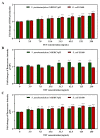Environmentally Relevant Concentrations of Tetracycline Promote Horizontal Transfer of Antimicrobial Resistance Genes via Plasmid-Mediated Conjugation
- PMID: 38891015
- PMCID: PMC11171790
- DOI: 10.3390/foods13111787
Environmentally Relevant Concentrations of Tetracycline Promote Horizontal Transfer of Antimicrobial Resistance Genes via Plasmid-Mediated Conjugation
Abstract
The ubiquitous presence of antimicrobial-resistant organisms and antimicrobial resistance genes (ARGs) constitutes a major threat to global public safety. Tetracycline (TET) is a common antimicrobial agent that inhibits bacterial growth and is frequently detected in aquatic environments. Although TET may display coselection for resistance, limited knowledge is available on whether and how it might influence plasmid-mediated conjugation. Subinhibitory concentrations (3.9-250 ng/mL) of TET promoted horizontal gene transfer (HGT) via the mobilizable plasmid pVP52-1 from the donor Vibrio parahaemolyticus NJIFDCVp52 to the recipient Escherichia coli EC600 by 1.47- to 3.19-fold. The transcription levels of tetracycline resistance genes [tetA, tetR(A)], conjugation-related genes (traA, traD), outer membrane protein genes (ompA, ompK, ompV), reactive oxygen species (ROS)-related genes (oxyR, rpoS), autoinducer-2 (AI-2) synthesis gene (luxS), and SOS-related genes (lexA, recA) in the donor and recipient were significantly increased. Furthermore, the overproduced intracellular ROS generation and increased cell membrane permeability under TET exposure stimulated the conjugative transfer of ARGs. Overall, this study provides important insights into the contributions of TET to the spread of antimicrobial resistance.
Keywords: antimicrobial resistance genes; cell membrane permeability; conjugative transfer; reactive oxygen species; tetracycline.
Conflict of interest statement
The authors declare no conflicts of interest.
Figures






Similar articles
-
Characterization and transmission of plasmid-mediated multidrug resistance in foodborne Vibrio parahaemolyticus.Front Microbiol. 2024 Jul 31;15:1437660. doi: 10.3389/fmicb.2024.1437660. eCollection 2024. Front Microbiol. 2024. PMID: 39144225 Free PMC article.
-
Triclosan at environmentally relevant concentrations promotes horizontal transfer of multidrug resistance genes within and across bacterial genera.Environ Int. 2018 Dec;121(Pt 2):1217-1226. doi: 10.1016/j.envint.2018.10.040. Epub 2018 Oct 30. Environ Int. 2018. PMID: 30389380
-
Effects and mechanisms of plant growth regulators on horizontal transfer of antibiotic resistance genes through plasmid-mediated conjugation.Chemosphere. 2023 Mar;318:137997. doi: 10.1016/j.chemosphere.2023.137997. Epub 2023 Jan 28. Chemosphere. 2023. PMID: 36720410
-
Effects and relevant mechanisms of non-antibiotic factors on the horizontal transfer of antibiotic resistance genes in water environments: A review.Sci Total Environ. 2022 Feb 1;806(Pt 3):150568. doi: 10.1016/j.scitotenv.2021.150568. Epub 2021 Sep 24. Sci Total Environ. 2022. PMID: 34627113 Review.
-
Towards a better understanding of antimicrobial resistance dissemination: what can be learnt from studying model conjugative plasmids?Mil Med Res. 2022 Jan 10;9(1):3. doi: 10.1186/s40779-021-00362-z. Mil Med Res. 2022. PMID: 35012680 Free PMC article. Review.
References
-
- O’Neill J. Tackling Drug-Resistant Infections Globally: Final Report and Recommendations. Review on Antimicrobial Resistance, London. 2016. [(accessed on 12 November 2023)]. Available online: https://amr-review.org/Publications.html.
-
- Vinayamohan P.G., Pellissery A.J., Venkitanarayanan K. Role of horizontal gene transfer in the dissemination of antimicrobial resistance in food animal production. Curr. Opin. Food Sci. 2022;47:100882. doi: 10.1016/j.cofs.2022.100882. - DOI
Grants and funding
LinkOut - more resources
Full Text Sources

